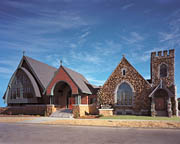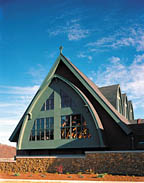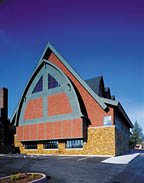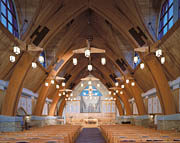

"The Nolichuckey River is a nearby mountain river," said Principal Architect James F. Williamson, AIA, of Williamson Pounders Architects (WPA) in Memphis, TN. "They have been dredging stone from the river for more than 100 years. [The church] has been a landmark in downtown Johnson City for most of that time - mainly for its eccentric use of stone. It's known locally as the 'Rock Church.' "
When describing the original architecture of St. John's, the architect explained that the exterior looks as though it is composed of large pebbles. "When I say pebbles, I mean stone that has been rounded by the water," he said. "When we were ready to do the new nave, everybody was very interested in the possibility of building with the same river rock. We did a little research, and then some Church members found the company that supplied the original stone. It was still in business, so the stone came from the original site."
Although the course of the river has changed during the past 100 years, the quarry has remained the same, according to Dr. Ben Hall, chair of the Building Committee. "The river rock was taken from the same plane that the original river rock was on," he said. "The new rock looks the same." Hall explained that for the original construction, the stone was hauled by a flatbed wagon pulled by horses to the site, which was about 15 miles away from the quarry. "That same quarry still exists and has been mined for sand and gravel since then," he said.

The expansion
The new nave, which seats 350 people, was built in response to a new growth in membership as well as the revitalization of downtown Johnson City. In addition to providing a larger room for worship, the new annex also offers more office, sacristy and classroom space. While the design team at WPA wanted the new design to complement the Gothic revival style of the first building, they also believed it was important for the addition to have its own characteristics."The new addition should be compatible and complementary, but not identical," said Williamson. "A knowledgeable person should be able to tell the difference [between the two]." As a result, the exterior of the nave is clad in cedar shakes, and the local river rock was used for the base of the building.
Although the firm did not have to consult a local historical society about the design for the addition, the architects did take the existing architecture into consideration. "We didn't have to work with a preservation committee, but we were just as careful," said Williamson. "We do a lot of historical preservation work, so we are at least as concerned as a preservation official about being compatible with historic architecture. We made sure the roof pitch matched the roof pitch of the original building, the stone matches, and the size and shape of the windows are very similar - wherever we could, we used the original building as a point of departure."
Inside the new building, the use of the river rock continues. The material was employed for piers, which are bases for interior wood arches. "Large Oak arches - 6 feet from the floor - rest on the piers," said the architect. "So the stone holds the weight of the roof."
Williamson explained that the stone comprising the exterior of the original church was coated with a waterproofing sealant, which changed the color of the stone slightly. "It was clear, but made the colors a little deeper," he said. "When we laid up the stone [on the nave], there was an apparent difference, so we put the same sealer on [the stone]." According to the architect, the sealant was not used for the interior stonework, since the river rock was not being compared to any existing stone.

Finding a stonemason
One challenge WPA faced for this project was finding a stonemason that could reproduce the stonework in the manner that it was originally laid up, according to Williamson. "It is sort of like loading bowling balls on top of one another," he said. "The mortar joints are deeply recessed to get a very three-dimensional appearance. The stone is projecting out from the face of the wall. It was very important to us that we could reproduce that."In the end, Powell Building Group, the general contractor for the project, found the right stonemason for the job, according to the architect. "We had [the masons] prepare a sample panel," he said. "We had it built right outside the walls of the church, so it could always be used as a comparison."
Construction of the new nave took approximately 12 months to complete, according to Williamson. "It took about a year to build, [but] the planning took longer than that," he said. "We had been working with the Church for two years before construction. It went relatively smoothly. It was on time and on budget."
In addition to designing the new structure, WPA also custom designed the light fixtures and pews, according to the architect. The firm was recently honored for its work on St. John's Episcopal Church. It won the AIA Memphis Award of Merit for 2001.
